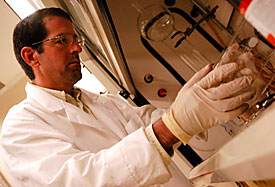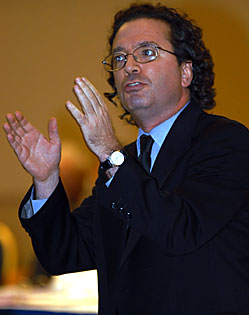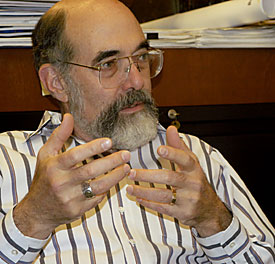 |
|
DEREKH FROUDE/Arizona Daily Wildcat
|
As science and technology takes off across the board, UA takes a special interest in the field of biosciences. With a new biosciences research area in the works for the university, local scientists have high hopes for UA's future contributions to the growing field.
|
|
By Jeff Sklar
Arizona Daily Wildcat
Thursday May 1, 2003
Editor's note: This is the first in a two-part series on UA research in biosciences. Tomorrow will feature the economic impacts of that research.
More than 50 years have passed since two British scientists discovered the structure of DNA. Their finding marked the first step in what has been a half-century-long process of unlocking the molecule's mysteries.
Now, scientists have mapped the human genome. Research is leaping beyond learning DNA's structure, and scientists around the world are searching for ways to apply their newfound genetic knowledge toward improving quality of life.
And UA wants a piece of it.
Within a few years, scientists say, research conducted at UA could allow patients with a difficult-to-diagnose illness to check into a hospital for treatment based on their specific genetic makeup, rather than the one-size-fits-all medication they might get today.
The field that will turn this dream into a reality is known as biosciences, and aside from the implications it could have on human health, it is also one of the fastest-growing and most profitable in the nation.
But researchers and administrators say that if UA will make it to the forefront of the biosciences field, researchers across the life sciences will need to reevaluate how they do their jobs.
 |
|
DAVID HARDEN/Arizona Daily Wildcat
|
Dr. Fernando Martinez, head of the Arizona Respiratory Sciences Center, speaks about how biosciences research could revolutionize current medical treatments.
|
|
Advancing medical science
Imagine going to the doctor with a bone disease and being told that a new machine could re-grow your bones. A local company started by two UA researchers is working on a machine that the company's scientists expect will do just that.
At Focal Point Microsystems, which was started by Joe Perry and Seth Marder, two faculty members with joint appointments in the chemistry and optical sciences departments, researchers are using technology that allows them to create three-dimensional microstructures.
You almost have to squint to see the tiny chips they create, but because they're three-dimensional, they can be used for more powerful purposes than two-dimensional chips in use today.
One day, said Gordon Janaway, a senior scientist at Focal Point, that technology could be used for a machine that would create an artificial bone scaffold.
Then, the patient's bone cells could be placed on the scaffold, where they would multiply. Gradually, the scaffold would be broken down and the patient's bone would re-grow itself.
That technology is just one potential application of research in the biosciences, a field that people across the university say will revolutionize medical treatment.
Whenever the Arizona Board of Regents meets at UA, it spends 15 minutes listening to one of the university's top researchers discuss his or her work. In recent meetings, President Pete Likins has brought some of the university's top biosciences researchers to tell the regents about the possibilities of unlocking the secrets of the genome.
At last week's meeting, Dr. Fernando Martinez, who heads the Arizona Respiratory Sciences Center, told regents about how biosciences research could revolutionize treatment for asthma, a disease that plagues thousands of Arizona children.
Martinez described the current method of treating asthma, as well as most other diseases as, "Take this medicine and if you don't feel well, call me."
That will change.
People's genetic makeup affects how they react to different drugs. In fact, the average drug only works for about 60 percent of people, said Dr. Ray Woosley, the vice president for health sciences.
"For almost every medicine we give, people respond differently because they have a different genetic makeup," Martinez said.
Martinez said continued research in the biosciences could lead to prescribing different medications depending on people's genetic makeup. It would be a paradigm shift in medicine, and one that researchers think will lead to better health care.
"We are participating in something that will create the medicine of the future," Martinez said.
Woosley described it as informed treatment. Likins has called it "medicine at the molecular level."
However it's defined, its applications are far-reaching. But for UA to be at its cutting edge, administrators and researchers say the university needs to continue a commitment to changing how research is conducted.
 |
|
CHRYSTAL MCCONNELL/Arizona Daily Wildcat
|
Tom Baldwin, director of the Institute for Biomedical Sciences and Biotechnology, will lead UA's efforts to move to the top of the biosciences field.
|
|
Breaking down barriers
In Professor Vicki Chandler's plant sciences lab, student workers prepare and conduct experiments, enter data into computers and analyze results. The subject of their work: Corn.
The information that can be gleaned from studying corn can be transferred to other living organisms, including humans. The processes of turning corn genes on and off doesn't change, whether you're talking about corn, fruit flies or humans.
"Gene regulation is fundamental to all organisms," Chandler said.
Legal and practical limitations prevent Chandler from conducting the same research on humans. It's easy to plant 100,000 specimens of corn, but not so easy to find 100,000 human test subjects. Fortunately, the similarities in the genome mean the discoveries Chandler makes on corn can be easily transferred to humans.
The problem, Chandler said, is that she can't always communicate with human disease researchers at the Arizona Health Sciences Center. Chandler's lab sits on the fifth floor of the Marley Building, just south of the Mall.
It's not an environment that fosters collaboration, which means workers in one lab may be finding answers to questions that people in the lab down the hall also need answers to.
Walk down the halls in the Marley building or one of the other buildings that houses scientists, and you'll see signs like "Gang Lab" or "Zhu Lab." In those labs, professors work to answer specific scientific questions.
Physical distances are a problem, said Tom Baldwin, who heads the biochemistry department, but so are traditional boundaries that keep researchers from interacting with people outside their own college, or even collaborating at all.
Nationwide, that's a problem that's beginning to change, he said. Baldwin recalls that in the 1970s, scholarly articles in his field were typically written by one to three authors. But on a recent Friday afternoon in his office, Baldwin pointed to an article with seven authors from several different universities as evidence that the trend is reversing.
"The problems are such that no one person has all of the understanding that you need to solve the problem," Baldwin says.
When Paul Sypherd, who was then UA's provost, returned from a sabbatical in 1999, he presented to Likins the beginnings of the answer to that problem.
Sypherd, a molecular biologist trained as a microbiologist, called for, among other things, a stepped-up commitment to biosciences research.
But, he said, traditional university boundaries between departments and colleges would keep researchers from sharing information with each other, meaning people would often miss out on discoveries that could affect their own work.
In his sabbatical report, Sypherd called for tighter collaboration between the Colleges of Science, Medicine, Pharmacy, Nursing, Public Health and Agriculture and Life Sciences, a group of colleges that extends beyond the traditional boundaries of the medical field.
"One of the obstacles comes from our own culture," Sypherd said. "Oftentimes, (we) spend our entire academic career on some niche we've carved out of the body of ignorance."
But the old notion that scholarly research should be independent has been a hard mold to break. Ten years ago, UA policy dictated that professors on the tenure-track wouldn't get credit for publishing scholarly articles if another faculty member had co-authored the article.
That's not the case now, but Sypherd cited it as an example of the cultural barriers that needed to be corrected to facilitate collaboration.

INFORMATION COURTESY OF FACILITIES DESIGN AND CONSTRUCTION
|
Building the future
Today, those barriers are breaking down. Researchers across the life sciences are collaborating, and the most prominent way is in the new Institute for Biomedical Sciences and Biotechnology. Baldwin is its director, and Chandler and Martinez serve as co-directors.
The centerpiece of the institute will be a $65.7 million, 170,000 square foot building where researchers from across the life sciences will work together, hoping to reap the benefits of collaborative research.
Regents just approved its construction last week, and it's scheduled for completion at the end of 2005.
"(Scientists are) going to be talking to each other while they're working, and they're going to be teaching each other, and they're going to be learning from each other," Baldwin said.
The IBSB building will also contribute another 150,000 square feet of research space to a campus that is 500,000 square feet short of what the National Institutes of Health considers an ideal amount, Baldwin said.
UA is also planning to build a $54 million, 150,000-square foot medical research building next door to IBSB. Those two buildings will form what UA leaders hope will become a corridor of biosciences research north of East Speedway Boulevard.
Administrators hope the Legislature will pay for both buildings, and a Senate committee voted in February 9-0 in favor of funding both of them. Regardless of whether the state pays for them, administrators have said neither will be paid off with tuition.
The investments in biosciences collaboration are also coming from Proposition 301, a voter-approved sales tax passed in 2000 that, in part, helps fund university research.
Even in a state budget crisis, it hasn't been difficult to convince people to invest in biotechnology, said Dick Powell, vice-president for research and graduate studies. "It hasn't been a really hard sell," he said. "People still look to the future."
There's been some apprehension to spend so much money, said Dr. Raffi Gruener, a physiologist who serves as scientist-in-residence at UA's Science and Technology Park.
"A lot of people at the universities were apprehensive and still are," he said. "You just hope the investments pay off and they have a good chance of paying off."
Campus planners also plan to spend money in order to build a collaborative spirit into the area north of Speedway. By the end of 2005, they hope a north-south greenbelt will run along North Warren Avenue, connecting the Arizona Health Sciences Center with the biosciences buildings.
Planners say an attractive greenbelt would encourage people to leave their buildings to talk with researchers working nearby.
Baldwin calls traditional departments and colleges "silos" that prevent people from collaborating. And at last week's regents' meeting, Adam Gross, a principal at Ayers Saint Gross, the planning firm, which is creating the long-term campus plan, used the same word when referring to buildings people don't want to leave.
"(The greenbelt) is not just an architectural plan but a pedagogical plan · that gets people out of their silos," Gross said.
From his seventh floor office in the Administration building, President Pete Likins can see much of North Tucson. In the foreground lies the Arizona Health Sciences Center, where professors in UA's medical school conduct research in fields ranging from cancer biology to respiratory sciences.
Sitting in his office nearly a year ago, Likins pointed to the health sciences center and the surrounding area, saying he hoped it would become a hotbed of biosciences research.
Likins' expectation is slowly becoming reality, and though it will be more than two years before the IBSB building is opened, administrators and researchers across campus don't hide their excitement when they talk about the doors that will be opened by a stepped-up commitment to the biosciences.
"We've found ways to integrate faculty who are doing similar kinds of work," Likins said at last week's regents meeting. "It's a very exciting process."

